Taiwanese own a third of land in corridor: ERI official
Jaguars are a fearsome and majestic wildlife attraction in Belize. Hundreds exist across the western and southern corridor, but without an adequate multi-stakeholder strategy, this vestige population which resides in Belize’s verdant forests will continue to face the threat of extinction.
One vital element of preserving Belize’s jaguar population, according to Dr. Elma Kay, Terrestrial Science Director at the Environmental Research Institute (ERI) of the University of Belize, is maintaining the biological corridor, in order to ensure that subpopulations in Rio Bravo and the Cockscomb Basin have enough contact to allow the kind of intra-species, genetic mixing to guarantee the survival of the jaguar (scientific name is Panthera onca).
Kay said that three multi-national developers, namely Green Tropics, Belize Sustainable Agriculture, and Belize Farms Limited, own a significant chunk of the lands which serve as the jaguar corridor through which the “Big Cat” migrates. They own just about a third – with another one-third being owned by the Taiwanese community. The remaining third is owned by small landowners and communities, in several villages — Cotton Tree, St. Matthews, Franks Eddie, More Tomorrow, all the way to Hattieville, which lie within the corridor.
Kay said that the other big issue they are tackling is conflict with cattle, because of problems arising from free-range cattle farming. She told us that they are trying to promote better husbandry practices and the use of fences – to protect cattle from falling prey and to protect jaguars from confrontations that could lead to them getting killed.
Last Friday, the ERI signed a tripartite agreement with the Ministry of Fisheries, Forestry and Sustainable Development and Panthera – a US-based NGO whose main mission is the conservation of the jaguar.
Panthera has an established partnership with ERI, and it has been providing vital support for the wildlife program at the institute. Panthera’s staff has an office in Belize, and they fund several positions at the ERI.
On Thursday, February 20, Dr. Alan Rabinowitz, the CEO of Panthera whose work in Belize led to the creation of the world’s first jaguar reserve at the Cockscomb Basin, and Minister of Forestry, Fisheries and Sustainable Development Lisel Alamilla officially inaugurated additional installations to the ERI.
Then on Friday, February 21, the three parties signed a 5-year Memorandum of Understanding, which Dr. Kay says solidifies their long-standing collaboration.
Dr. Kay said that they are also working on the development of a management plan for the central Belize corridor. The initiative, which started at the end of 2013, entails the creation of a conservation action plan. The process will require the involvement of all major stakeholders.
At their meeting held in December 2013, the need to preserve wildcat habitat, and the need for water preservation, were clearly emphasized.
A series of workshops have been held since the year began – the most recent of which were held last week, concluding with the signing of the MoU.
According to Dr. Kay, Green Tropics, which plans a mega sugar development for western Belize, was present for the discussion. She said that they want to work together to ensure that within this landscape of development there can still be a jaguar corridor.
Amandala readers will recall that back in 2012, Green Tropics was ordered to pay damages after the ERI complained that the company had initiated unauthorized works, dredging a canal of approximately 2 miles long with 4 excavators on public lands, severing the Laboring Creek Jaguar Corridor Wildlife Sanctuary, which was granted protected status in late 2010.
Kay said that they also hope to meet shortly with representatives of the Ministry of Agriculture and the Taiwanese community, which owns a lot of the land within the jaguar corridor.
As for law enforcement issues, they will also have to dialogue with policy and military officials, as well as other law enforcement authorities in Belize before the new strategy is finalized.
The tripartite MoU calls for a strategic action plan, with a corresponding annual plan of operations.
The document says that, “Panthera [the NGO] can provide immediate and good-faith actions to begin the above process by supplying maps of the Central Belize Corridor and the Southern Belize Corridor, both of which have been defined through research and analysis.”
It added that Panthera and ERI will seek support for, and develop, stakeholder meetings in the central Belize corridor to develop a conservation action plan and implement it; and Panthera and ERI will provide boundary marking and initial monitoring of the Labouring Creek Jaguar Corridor Wildlife Sanctuary.
The MoU provides for an automatic roll-over, except if 90 days’ notice is given for its termination.

